This website uses cookies so that we can provide you with the best user experience possible. Cookie information is stored in your browser and performs functions such as recognising you when you return to our website and helping our team to understand which sections of the website you find most interesting and useful.
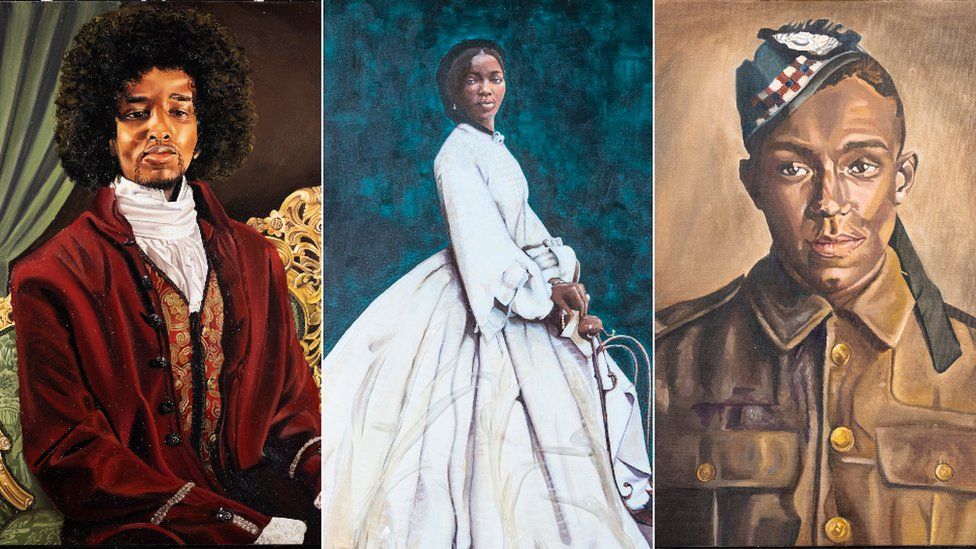
A new English Heritage exhibition unveiled on Wednesday aims to shine a light on figures traditionally forgotten by England's cultural history.
Painting our Past: The African Diaspora in England draws together new portraits of six historical figures - spanning Roman Britain to the 20th Century - that reflect the long history of African people in England.
The figures include Septimius Severus, an African-born Roman emperor who strengthened Hadrian's Wall, and James Chappell, a black 17th Century servant at Kirby Hall in Northamptonshire who saved the life of the then owner, Sir Christopher Hatton.
The paintings are on display at the English Heritage-linked forts, abbeys, historic houses and barracks where these individuals lived, visited or worked. This includes the return of the portrait of Sarah Forbes Bonetta, Queen Victoria's African goddaughter, to Osborne House, Victoria's seaside home on the Isle of Wight.
Anna Eavis, English Heritage's curatorial director, said: "African figures from the past have played significant roles at some of the historic sites in our care but many of their stories are not very well known.
"Placing their portraits on the walls of those sites is one way we hope to bring their stories to life and share them with a wider audience."
The exhibition's new portraits have all been commissioned from artists who themselves identify as black or mixed-heritage - read on to learn about their subject's stories

Arthur Roberts (1897-1982) at Berwick-upon-Tweed Barracks, Northumberland by Chloe Cox
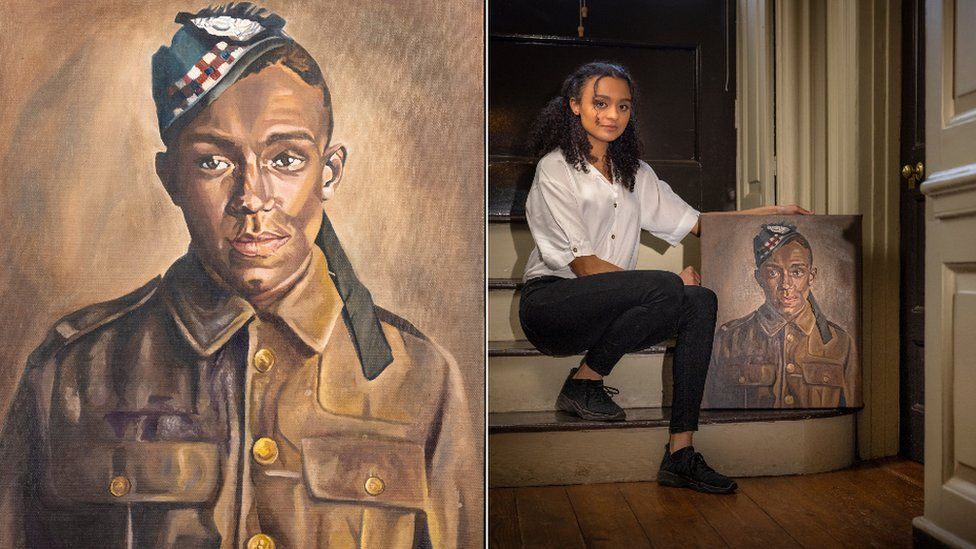
Chloe Cox's portrait depicts Arthur Roberts, the son of a Trinidadian man, who was born in Bristol and brought up in Glasgow.
Roberts enlisted with The King's Own Scottish Borderers, a line regiment of the British Army, in February 1917, aged 20. Based in barracks at Berwick-upon-Tweed, those within the regiment would have felt a strong affiliation with the barracks as both operational and emotional home.
Roberts fought during the World War One and survived the Battle of Passchendaele.
Cox, winner of both the 2020 Southwest School of Art Young Artist and Young Portrait Artist of the Year awards, says: "I am an oil painter, working predominantly on canvas. My art seeks to represent the underrepresented and to empower minority ethnic individuals, increasing their sense of belonging in British arts, history and culture.
"As a woman of mixed heritage and identity, I refrain from idealised distortions of character and focus on bringing about the raw, the real and the authentic.
"My realism style won't smooth the cracks or sweeten the features, it aims to capture the truth, from the likeness of the face to the slightness of a familiar expression."
Dido Belle (1761-1804) at Kenwood, London by Mikéla Henry-Lowe
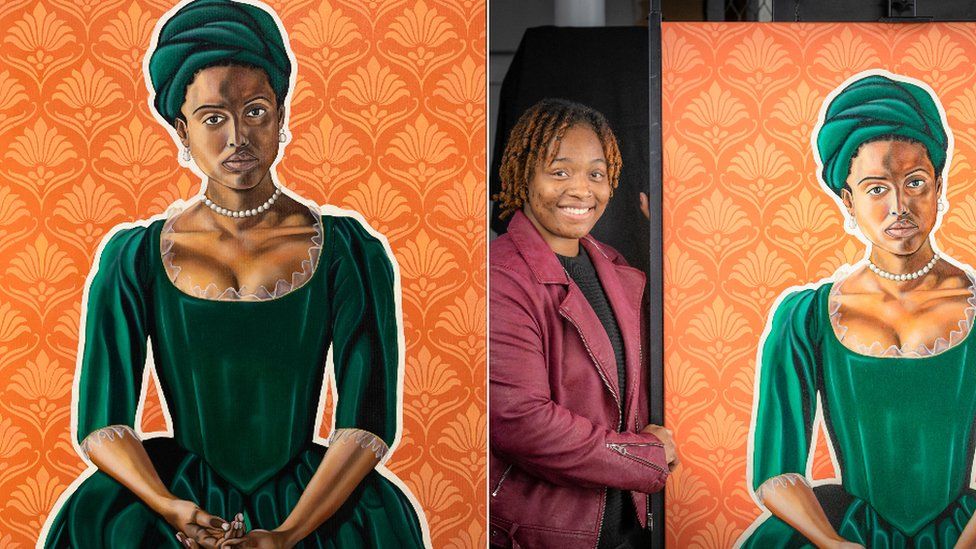
Mikéla Henry-Lowe's portrait depicts Dido Belle, the daughter of a young enslaved black woman and a Royal Naval officer. Born out of wedlock, Dido was raised as part of the aristocratic Murray family in Georgian London and spent much of her life at Kenwood House on Hampstead Heath in north London.
Henry-Lowe, a Jamaican-born artist who focuses on the representation of black women in society, says: "I wanted to paint Dido Belle because a lot of my portraits are of black women wearing head wraps representing black culture, but Dido's head wrap isn't cultural. It was most likely to cover her hair because at the time many didn't know what to do with curly hair.
"I think it's amazing that I've been given the opportunity to paint a black woman who experienced growing up in an aristocratic family, because most depictions of black women in Georgian Britain were shown as slaves."
Emperor Septimius Severus (145-211) at Corbridge Roman Town on Hadrian's Wall, Northumberland by Elena Onwochei-Garcia

Elena Onwochei-Garcia's portrait depicts Roman Emperor Septimius Severus, who was born in Leptis Magna (present day Al-Khums, Libya) in the Roman province of Africa. Septimius travelled to Britain in AD 208. He strengthened Hadrian's Wall and reoccupied the Antonine Wall with a view to expanding his empire.
Onwochei-Garcia, who says she explores the expression of racial issues and ideologies through humour, as well as how they shift over time within power dynamics, explains: "I was drawn to Severus because of the parallels with my own mixed heritage status (Nigerian, Spanish and German), and this made me reflect on how people might imagine someone like us to look like.
"I wanted to go beyond painting Rome's African emperor, to portray a complex individual by paying attention to his personality and how he chose to be seen in his coins, statues and architecture. Historically black people have had little control over their portrayal. Severus embodied and altered the image of the Roman Empire."
Abbot Hadrian (640-710) at St Augustine's Abbey, Kent by Clifton Powell
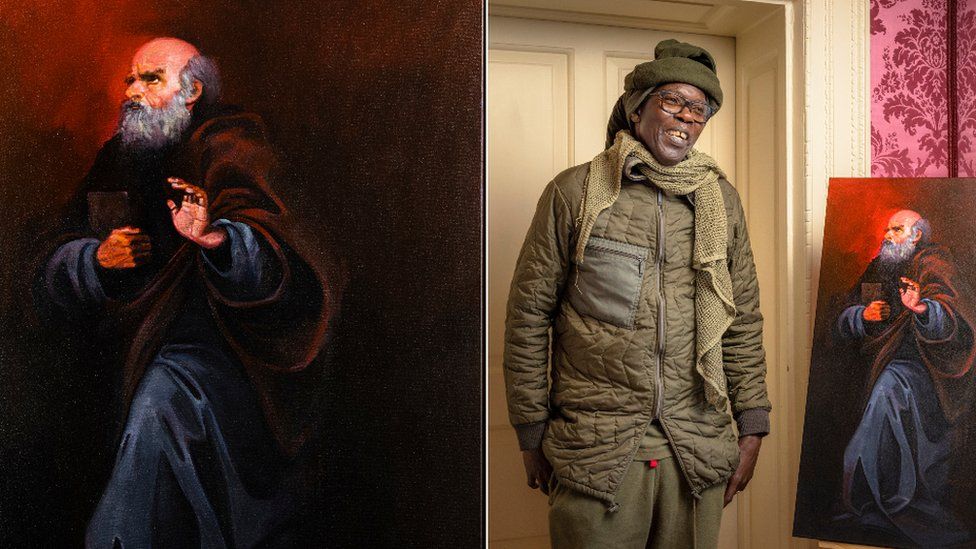
Clifton Powell's portrait depicts Abbot Hadrian, an African scholar in Anglo-Saxon England and the abbot of St Augustine's Abbey. He was from Cyrenaica, a Roman/Byzantine province in North Africa.
Powell, who studied at the Jamaican School of Art in Kingston and has had work featured at numerous UK exhibits, including the International Black Art fair, says: "I am a British artist, born in Jamaica. St Hadrian has been part of my life since I began his portrait. I sense his presence, so this gives me inspiration to paint him.
"I feel I need to bring him to life, all the paintings I have seen of him bring me back to his time. He has captivated me with his spiritual presence and I feel him near, and while painting, I played Gregorian chants, as in a Monastery setting."
Sarah Forbes Bonetta (1843-1880) at Osborne House, Isle of Wight by Hannah Uzor
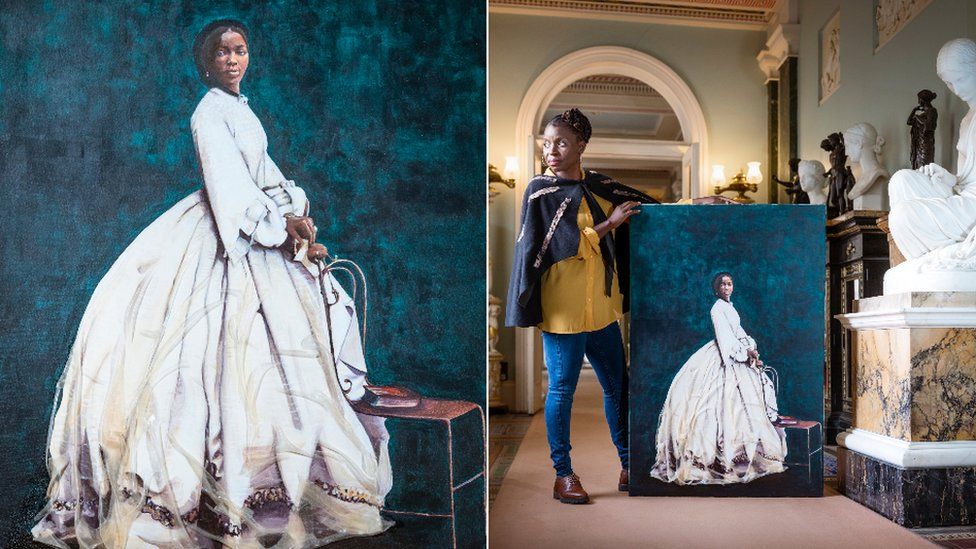
Hannah's Uzor's portrait depicts Sarah Forbes Bonetta, the daughter of a West African ruler, who was captured and enslaved by King Gezo of Dahomey (present-day Benin) aged five.
Originally named Aina, she was presented as a so-called 'diplomatic gift' to Captain Frederick Forbes of the H.M.S. Bonetta and brought to England in 1850.
Soon after their arrival, Forbes introduced her to Queen Victoria who grew so attached that she paid for her education and became her guardian - recognising her as her goddaughter. Sarah visited Osborne house, Queen Victoria's seaside home on the Isle of Wight, a number of times during her life.
Uzor, who is largely self-taught, having honed her skills in the Zambian artistic community as a teenager before moving to the UK, says: "In my artistic practice I explore the complexity of the black identity and experience. I specifically want to highlight the hidden histories and often invisible narratives of people racialised as Black in modern day history.
"During research I came across Sarah Forbes Bonetta in David Olusoga's book Black and British. I was drawn to Sarah's story because of her multi-layered identity and the parallels I could see in my own family, particularly for my children, who share Sarah's Nigerian heritage."
James Chappell at Kirby Hall, Northamptonshire by Glory Samjolly

Glory Samjolly's portrait depicts James Chappell, a black servant at Kirby Hall. He entered the service of the Hatton family aged 15, and in 1672 saved Kirby's owner, Christopher Hatton, from the rubble of an explosion on Guernsey. After Christopher's death in 1706, James was presented with pension of £20 a year. A life-changing amount of money at the time, James used it to set up home in the local area with his wife.
Samjolly, who created the social enterprise Black Aristocratic Art in 2019 to 'decolonise' the mainstream art history curriculum, says: "There is not enough representation of African Europeans in historical galleries or textbooks, and most often when they are represented it is as slaves, servants or abolitionists.
"I could have painted James Chappell as a servant, but there was not enough information to determine the kind of role he had, except he was favoured a great deal, and became a legend for saving Sir Christopher Hatton. I decided to paint him in the latter years of his life, with a more stoic and integral stance, a kind of man who would look back at his life and be proud."

Painting our Past: The African Diaspora in England runs from 9 June to 5 November 2021.



 Africana55 Radio
Africana55 Radio 
